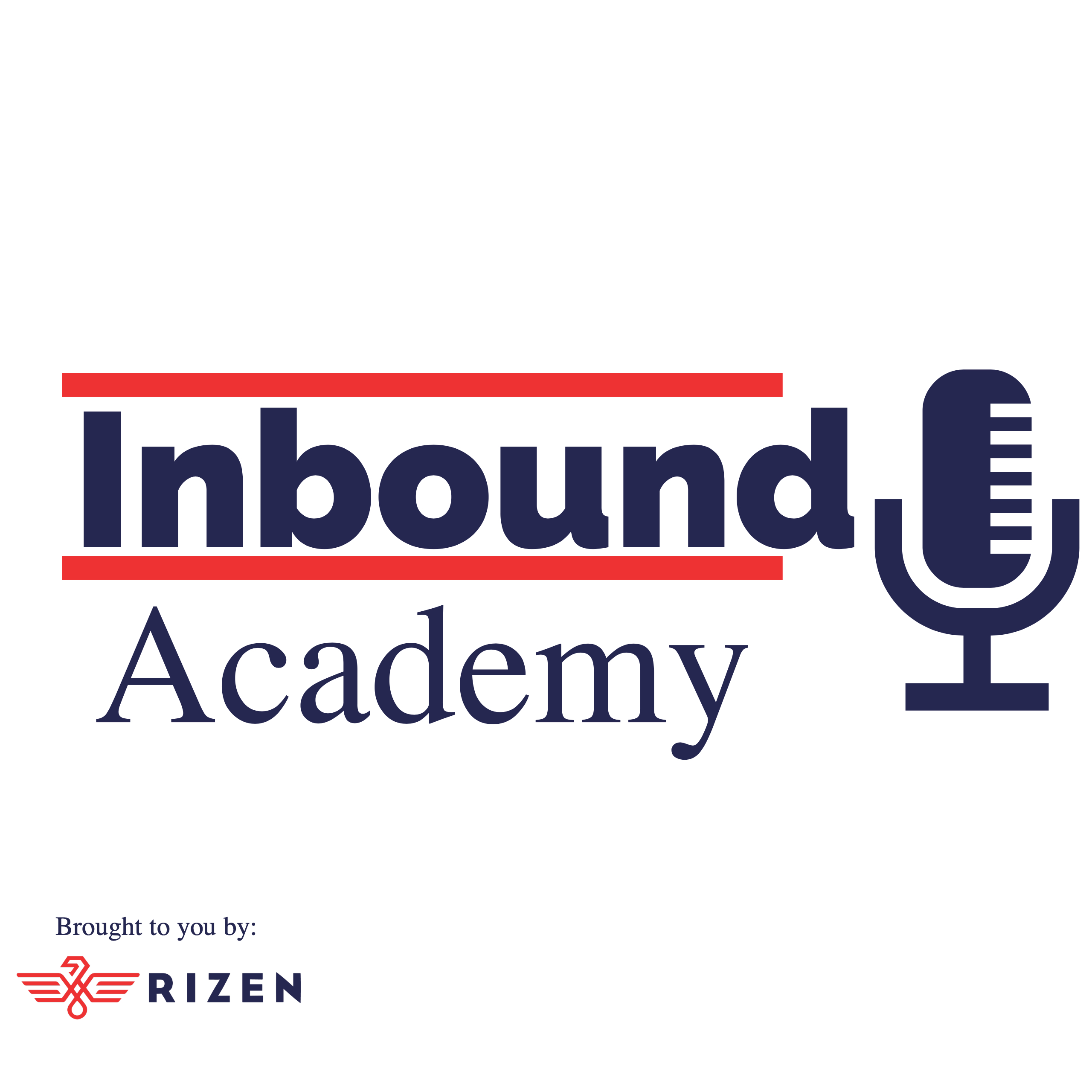Today on Rizen Academy we’re going to wade away from the shallow end up to our...belly buttons in the inbound pool. We’ve learned about why modern tactics are needed to reach today’s customers, so let’s deflate the floaties and jump right in the inbound methodology.
Episode Transcript
Jeff Lambert: And welcome to the show everybody. I'm your host, Jeff Lambert. Hey, if you're a new listener, we hope that you're going to take some time to go back and listen to some of our previous episodes because they're all meant to build on each other. If you're tuning in as a repeat listener, thank you for choosing us and we look forward to growing with you. For our episode today, I have Rogelio Rodriguez, the CEO at Rizen. He's joining us today to talk a little bit more about the inbound methodology. Rod, thanks for coming back today to talk about this.
Rogelio "Rod" Rodriguez: Thanks for having me, Jeff.
Jeff: So to review where we've come so far, Rod, we've talked about how traditional marketing and sales just really aren't that effective anymore, and we were talking about why inbound is different. If you could summarize how inbound is different in a nutshell, how would you describe it?
Rod: Sure. You know, inbound is really a methodology that was developed in response to how humans have changed in their buying process. Whereas in the past, it may have been a world where the salesperson had all the power and they dictated how the sale went along because they had all the product information. All the knowledge that that was available about a product was held by the sales individual. Now, you're looking at a world where the information is out there, the information is on the Internet in large part due to the search engines like Google that are documenting every single piece of information that's out on the Internet. So the methodology takes that into account and puts together a process of how to attract the modern buyer, engage with them and really turn that individual into a customer - a lifelong customer.
Jeff: Now, inbound has a specific methodology that you're supposed to follow to be able to do all of those things with customers. Is that correct?
Rod: Yes. Yes it is.
Jeff: So that's called the inbound methodology, if I remember right. Could you talk about what the steps are to that methodology?
Rod: Sure. They are 1) Attract 2)Engage, and 3) Delight. Those are essentially the three stages or steps of the methodology.
Jeff: So why don't we go ahead and break those down. Let's start with attract. What does that mean? Let's break that down.
Rod: All right. So in the attract phase of the methodology, you're creating content that positions you as a knowledgeable and helpful - an expert. You're making yourself available to help people, making the content easy to find, and engage with them online.
Jeff: Could you provide an example of, say I'm sitting in front of my computer and I want to buy a new lawnmower. What would a business do in order to attract me using that first step in the methodology?
Rod: You know, it could be a review of the best lawnmowers that are available on the market today. A comparison, right? Or a guide to buying your first lawnmower for first-time homeowners. Content like that. Content that is aimed to help an individual make a choice. Whether this is going to attract them to you.
Jeff: I got it. So you're not necessarily forcing your service on the customer in this step, it's more about trying to be a helpful guide to them?
Rod: Yes, absolutely.
Jeff: Okay. So that would take us to the next step in the inbound methodology, which is to engage. What does that refer to?
Rod: So engagement is, is where you begin to collect information about the individual that you're working with by answering questions, providing solutions, and getting insight - becoming a resource online. So when I mentioned the guide just a few sentences back, that guide is meant to be that helpful resource. So you're going to exchange their contact information for that guide. That's how you engage, or that's one way of engaging. But you can also engage with chats, you can engage with them by answering questions on social media, or answering questions on other sites like Quora as well. So it's really how that interaction begins, right? How people are exchanging contact information for resources.
Jeff: Now it sounds to me like there's an element of trust that has to be there, right? The customer has to begin to trust you to start sharing that information. Is that correct?
Rod: Yes, absolutely. And I think you made a great point - that that trust is built through the content you're providing. Whereas a standard salesperson goes to sleep, your website doesn't. It works for you 24 hours a day, the more resources you're providing on it, the more chances you give an individual to engage with your content online. It'll help you build that trust through time.
Jeff: So there's really an absence of like high-pressure sales tactics using inbound, right?
Rod: Yes, it's a more subtle approach, where sales is involved at the moment where an individual requests it versus a sales individual going after somebody that's not requesting information.
Jeff: I mean, I can certainly appreciate that. You know, as a consumer myself, I tend to avoid places where I know I'm going to be in for some sort of high pressure type of situation where someone's going to be constantly just after me. "Oh yeah, I need your phone number, I need your email" this and that where I'm not getting really anything back because I wasn't interested in the first place. So this is, this seems to be a trend, I think that would speak to a lot of people. Especially this generation currently now that knows, "look, I don't need you to sell me something. I can just hop online to do it."
Rod: Yup. Absolutely.
Jeff: So let's go to that third stage. We have "attract" and we have "engage" and that leaves us with "delight." What does that mean?
Rod: So, the last stage of the methodology is really how you provide an experience that's so outstanding that your customer will become a brand advocate. And it's a lot easier to keep a customer, right? More cost effective than to acquire a new one. So the idea is to build a process and a way of making sure that every step of the way of your engagement with that individual is delightful, is fruitful for both organizations.
Jeff: Now, I'm trying to envision how I'm able to capitalize on that. If I'm a business, you know, and I know people are happy with my service. I'm hoping they'll leave a review on Google or Yelp or something like that. Do you have any advice for ways that people can take advantage of that base to really see how people feel about your product or your service?
Rod: Oh, yes, absolutely. You know, take advantage of every interaction that you have to request for feedback. If that feedback is not a 10 out of 10, then that ask how you can make that experience better. And try to make sure that all the positive feedback that you can get goes on online somewhere, whether it be Facebook, whether it be Google, or another third party site that would be helpful to provide an insight into the experiences that your customers are going through with you.
Jeff: And I guess to bring this all together. So we have three steps. We have "attract," we have "engage" and we have "delight" If you're following the inbound methodology. When I was reading about this myself, just trying to familiarize with the content I came across this phrase and it said, "to do inbound, you need to be inbound." With your company being an inbound marketing agency, what does that mean to other business owners?
Rod: Yeah. There's certain sets of principles that revolve around that makeup of an inbound company or an agency. Being inbound really is a living every day to holistically attract and delight your customers as much as you can. There is a helpful resource that everybody can take a look at or read. It's a book written in part by one of my mentors, Dan Tyre. He's a sales director at Hubspot, which is the partner agency that we partner with. It's called "Inbound Organization." Him and Todd Hockenberry wrote it and it's really how you can implement inbound principles to your business. Really how to make the most out of "attract, engage and delight" and really be ready for the changes that are coming in how humans interact and purchase and do business with organizations.
Jeff: I'll make sure to include a link for that in the show notes for our listeners. That way they can follow up with that book. And I guess to close Rod, since your organization adopted the inbound methodology and following principles of inbound, has it been beneficial for your business?
Rod: Yes, absolutely. You know, it's given us a renewed focus on growth and how to...how to grow ourselves internally as well as how to help our own clients grow. more effectively.
Jeff: Well, Rod, thank you for taking some time to talk to us about this topic today and I know we're going to have you back in the future to help our listeners educate themselves even more about inbound.
Rod: Thanks for having me, Jeff.
Jeff: Absolutely. And to our listeners, remember, you can expect a new episode every weekday, always no longer than 10 minutes and always filled with advice that's going to help you grow your business. And remember, if you're looking for an experienced, friendly and results driven team to help you, check out Rizen. You can see what services they offer at www.gorizen.com. You can also follow them on Facebook, Instagram, Twitter, and Linkedin by searching for the username Rizen Inbound. That's one word, Rizen Inbound. See you next episode. And thank you for joining us!
Want to stay in the know?
Join us, and get all the podcasts and more straight to your inbox.



.jpg?length=600&name=045%20-%20YouTube%20Cover%20Art%20(Video).jpg)


No Comments Yet
Let us know what you think